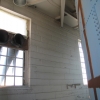Crescent Hill
Interior Tank
Shook Construction has contracted with Klenck Company to eliminate two large water tanks, one interior steel tank built in the 1920’s and one exterior concrete tank built at the turn of the century, located at the Crescent Hill WTP site in Louisville, Kentucky.
Klenck Company employed Howell & Howell, a local painting and abatement contractor, to abate the interior tank’s paint in a 5’x6’ grid pattern and the superstructure below, with each strip removed per industry practices to minimize heat transfer to the paint. Howell & Howell utilized needle guns to remove, capture, and dispose of the lead-based paint.
Once the abatement is complete, work will begin on the interior tank by installing nonflammable plastic partitions to isolate the tank room from the remaining occupied building. Two windows will be removed to allow for exterior clean air to enter the building during abatement and torch cutting operations and to exit the building through large ducts into a 40,000 CFM trailer mounted HEPA filtration collection system provided by Blast One. OSHA standard is 2000 CFM of air transfer per cutter (6000 total CFM needed). At 7.5 times the requirement, the Water Department will remain operational without interference.
Klenck Company will utilize burners from Parrick Michael Group to torch cut and remove the pre-determined panels of the holding tank. To execute the demolition, an air winch, will be attached to the top concrete deck; once fastened, the 5/8″ winch line will be thread through the 6″ 5 ton snatch block which is fastened through the truss directly over the tank. PMG will torch cut remediated steel tank panels and pre burn (3) rigging points in each panel, connect a 1 3/8″ 13.5 ton shackle to each corner and a tag line to the 3rd rigging point. Once connected each panel will be cut from scaffolding on the outside of the tank and will be lowered to the first floor. At the first floor, an access panel will be torch cut (approx. 10 x 10) to allow the removal of panels from above. Once panels are lowered, the tagline will help assist pulling panels through the access door where they are then taken by a grappled equipped, tracked material handling machine and remove the panels from the building. This method will be used to dismantle the entire tank, including the first floor and truss, in addition to the tank panels below the first floor and related piping.
Once the tank is removed to the start of the concrete liner scaffolding will be erected inside the tank. The concrete liner will be hammered/ chipped away from the tank walls, the accumulated debris will be removed by a super vacuum truck, and all concrete debris disposed for recycling. This process will be repeated multiple times during the concrete removal process.
Exterior Tank
Klenck Company will mobilize a Volvo 360 UHD excavator with a hydra-hammer and concrete processor to prosecute the work. Prior to demolition, sea cans will be erected to form a barrier between the elevated tank and the South filter building past the gutter line and around the exposed 48” and 8” lines as to not disturb them. Further, the lines will be protected using crane mat or timbers. Only a minimal distance will remain between the sea cans and tank. Geo-fabric will be draped over any additional building areas that may require protection from debris. To protect the Exterior Junction Chamber underneath the elevated tank, 12”x12”x6’ cribbing will be placed directly on the ground. Next, 65’ long I-beams will be installed on top of the cribbing allowing for a 12 inches of air space. Cross members will be welded into place between the I-beams for support. A layer of crane mat will cap the I-beams to further ensure the safety of the below ground structure.
Onsite rock will be utilized to cushion the parking area above the underground pipes. The Volvo 360 UHD excavator has a ground pressure of 430 pounds/ square foot, a significantly reduced force from the current traffic. Standard demolition practice requires the tracks of the machine to remain in full contact with the ground to ensure stability during demolition activities. The excavator will begin demolition of the tank with the concrete processor. The jaw will grab and break the concrete into 12” minus pieces minimizing potential impact energy and debris field. The hydra-hammer will be used on the thicker portions of the tank when necessary. The tank will be processed from highest point to lowest using standard demolition practices, removing concrete from the junction chamber protection daily. As the tank will be demolished from the top down versus from the sides, the area affected by debris will remain within the footprint of the existing fence surrounding the tank. The tank will be empty, thus the weight of the water will not act as a load on the tank. Demolition activities will not destabilize the structure in such a manner that will cause catastrophic collapse. The concrete will be removed from site and the protection system will be disassembled and demobilized.


















